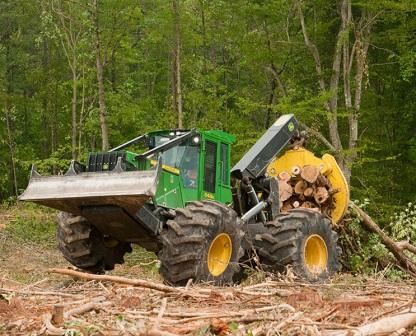Q: Sometimes in order
to speed things up, our skidder operator will delimb logs using what is called
“backing". This is where he takes the
logs with the skidder grapple and backs them into standing timber, knocking off
the limbs before they get to the landing.
Recently I was told that this was not a good practice and that we should
not do this anymore. Are there any BMPs
related to this, and why should we not do it?
A: Excellent question,
and one that certainly needs to be addressed.
While there are no BMPs that specifically mention “backing", it is
something that should not be practiced, especially if it is done in an area
where the trees will not be completely harvested, as is the case of a
Streamside Management Zone (SMZ).
Backing whole trees in for delimbing can cause excessive damage to the
residual stand, making them more susceptible to insects and disease and
possibly resulting in mortality. This
completely defeats the purpose of leaving them standing, and if in an SMZ, may
not provide the same level of water resource protection.
In addition to damaging
trees, the nature of this process involves equipment intrusion into the
SMZ. If you recall, Texas Forestry BMPs
call for equipment traffic to be kept to a minimum within the SMZ, as well as
for the “forest floor to be essentially undisturbed". By backing logs in, these BMP guidelines have
not been followed.
Another way in which
backing damages SMZ is the potential to create ruts at the edge of the
SMZ. Even if these ruts are small, they
can become a direct channel to carry runoff water to the stream and increase
erosion. You can also push back too far,
damaging the stream bank itself, and causing it to fail. While you may have strived to follow BMPs
across the entire tract, this simple process can negate the other BMPs by
delivering soil directly to the stream.
Texas Forestry BMPs
call for streams to be “clear or debris, such as tops and limbs”. While you may be pushing the limbs back at
the edge of the SMZ, you run the risk of pushing them into the stream. Even though tops and limbs can fall into the
stream bed naturally from storms and dead trees, there is no need to increase
this debris from a practice that is not necessary. As these tips and limbs decompose, they
release nutrients that can reduce water quality. When stream flow increases during rainy
weather, limbs and tops are pushed downstream and can dam up the stream,
increasing the potential for flooding.
As the limbs are pushed down even further, they can gouge the stream
banks, increasing the erosion that occurs naturally within the stream, as well
as increasing the amount of soil in the water.
In conclusion, even though skidder operators are well intentioned and are just trying to help out the guys up at the landing, this is a practice that needs to go by the wayside. It is not worth the damage that can be incurred to the SMZ or the stream, and I wonder about its’ efficiency to the overall operation. Keep the questions coming so we can shed some light on any best management practice confusion that might be out there, you can send your questions to me at tthomas@tfs.tamu.edu or just phone it in by calling (936) 639-8180.
*This article was published in the September 2012 issue of the Texas Logger

No comments:
Post a Comment